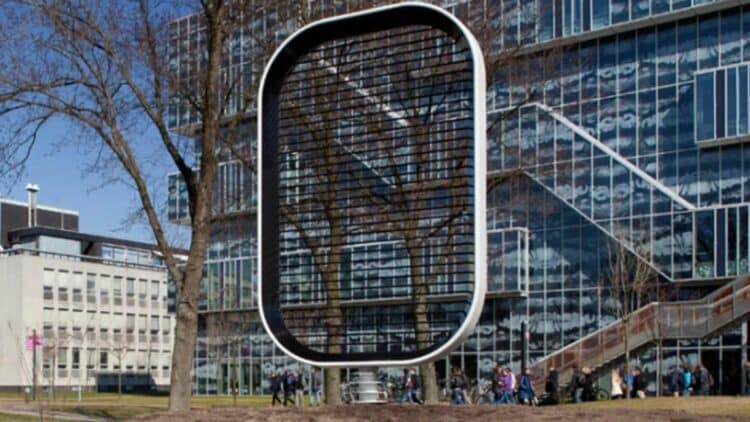In a world where turbines seem to be dominating the sustainable energy discussion, EWICON is silently turning moving air into volts using charged droplets and, in turn, is revolutionizing sustainable energy generation efforts. The remarkable EWICON device was unveiled by researchers at Delft University of Technology in the Netherlands back in March 2013, and this Electrostatic Wind Energy Convertor was said to be so special due to its lack of moving parts. Relying on water droplets to generate electricity, could EWICON provoke us to forget turbines completely?
Wind energy is generated in an alternative way, thanks to EWICON
Johan Smith and Dhiradj Djairam were the researchers from Delft University of Technology who brought the EWICON’s design to life in collaboration with the architecture firm Mecanoo. The design was built into an “O” shaped steel frame that was installed at the Delft University of Technology in 2013.
EWICON pushes electrically charged water droplets into the wind and is powered by airflow alone. In the process, wind energy is converted into electricity without a turbine. The way that it works is within the frame, a nozzle sprays the water droplets that are positively charged across a field of electrodes. With assistance from the wind, the droplets are moved away from the emitter, and the system’s electric potential increases. The ground plays the role of the negative collector, and if the voltage is great enough, electricity is generated.
The core premise behind the EWICON is the nozzles. There are no blades that will eventually require cleaning and replacement. The system is silent and safe, even for birds. There are no aesthetic complaints from this system, which looks neat without any large moving parts.
When lab experimentation leads to a sustainable solution
In theory, the system sounds flawless; however, the EWICON has resulted in practical results. The prototype on campus was the first installation, and thereafter the system was integrated into the rooftop signage of Stadstimmerhuis 010 building in Rotterdam. While both uses of the system did not contribute in any way to the grid, the integration of such a system proves that EWICON can fit into urban settings, particularly where large turbines are not a feasible option.
According to the researcher, Djairam, the system’s water droplets can hold quite a bit of energy in properly controlled situations. The microdroplets alone are able to yield about 100 watts of power under optimal conditions. If larger panels are to be created and the prototype is scaled up, the potential is immense.
While traditional wind turbines that contribute more effectively to the grid will always dominate conversations, innovations like EWICON prove that a different approach to energy creation is all that it takes to show a world where urban structures can even become energy generators.
Why do the charged water droplets work to produce energy?
Charged particles do seem like a fictional concept; however, the EWICON uses the principle of electric induction. When the wind blows, positively charged particles move away from the neutral emitter, so that the electric field builds up. Such potential can be stored and captured.
The aspects that determine how much charge each droplet can carry are the droplet size as well as the surface tension. There are some engineering challenges posed by atmospheric conditions and evaporation. The droplets also have to survive long enough in order to reach the collector, and that too without losing charge in any way. Like the honeycomb turbine, you can have free electricity from home should the EWICON become a scalable solution.
What is on the cards for the EWICON innovation?
EWICON has stepped in and is turning moving air into volts, while filling the gap where noisy and larger turbines cannot be used. This bladeless system can be effortlessly adopted in urban regions. Turbines will always play a leading role in energy generation; however, there is potential for EWICON to become a scalable solution. At present, progress remains slow and funding is limited, but EWICON is not ready to go silent. The question is: Does EWICON mean that it’s time to say farewell to wind turbines?


